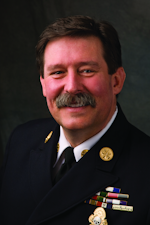As 2024 is now in our rearview mirror, let’s look at five important trends we saw in fire service law over the past year. The first involves the continuing trend of lawsuits targeting fire and EMS personnel who provided care at the scene of a law enforcement incident where a suspect died or was seriously injured. While this trend did not begin in 2024, it picked up momentum in terms of the number of suits filed and has continued to worsen.
In a nutshell, U.S. law enforcement is under intense scrutiny. In-custody deaths and injuries to arrestees and those experiencing mental health emergencies often result in civil suits that dissect every detail of the interaction between the individual and the police. Civil rights attorneys have expanded their target list to include fire/EMS personnel who responded to the scene.
In many of these cases, fire and EMS personnel draft their reports to align perfectly with their training and EMS protocols. This is likely a byproduct of concerns related to oversight by their superiors and medical director. Unfortunately, these reports do not align with what fire and EMS personnel actually did at the scene, a fact that plaintiffs’ attorneys are easily able to identify, because they review virtually every frame of every police body and dash cam video of the interaction.
Too often, the reports state that the patient was examined, vitals taken or that aid was refused against medical advice when the video shows fire and EMS personnel did not do so. When this happens once, it is too often. When this happens so often that the plaintiffs’ side civil rights bar discusses it at their continuing legal education programs, it might better be thought of as scandalous. This issue needs to become a focus of training and supervision in 2025.
AFFF & PFAS
A second trend that also accelerated greatly last year: suits against the manufacturers of aqueous film-forming foam (AFFF) and polyfluoroalkyl substances (PFAS). These substances are associated with various cancers and other life-threatening health conditions.
In 2024 alone, more than 6,500 lawsuits were filed against these manufacturers, bringing the current total to approximately 11,200 cases. Although many of the suits were brought by firefighters, firefighter unions and fire departments, others were brought by municipalities, states, drinking-water providers and private individuals. Often, these suits have multiple plaintiffs and were brought as class actions, an indication that the 11,200 figure is not representative of the number of people who were harmed by PFAS. Hundreds of thousands of people have been affected, and these suits show no signs of slowing down.
COVID-19 vaccine exemptions
The third trend relates to COVID-19 vaccine-related lawsuits filed by firefighters who were terminated after being denied an exemption from a vaccine mandate. These have largely been unsuccessful, whether brought on religious, disability, privacy, due process or other grounds. What changed was the Ninth Circuit Court of Appeals’ June 18, 2024, ruling in a case out of Spokane, WA.
In Bacon et al v. Woodward et al (No. 22-35611), the city of Spokane took a strict approach to the granting of exemptions to firefighters from the state’s COVID-19 vaccine mandate. Firefighters argued that the city’s blanket denial of exemptions for sincerely held religious beliefs could not be justified as being necessary for public safety. The trial court upheld the city’s decision, concluding that “stemming the spread of COVID-19 was a compelling [governmental] interest” that survives Constitutional “strict scrutiny.”
The Ninth Circuit disagreed. Applying strict scrutiny, the court found the firefighters’ argument compelling with regard to the city’s use of mutual-aid fire departments that freely granted exemptions for sincerely held religious beliefs. In other words, if being fully vaccinated against COVID-19 was so essential to public safety in Spokane that the city had to terminate firefighters who refused to be vaccinated, then how does the city rationalize allowing firefighters from mutual-aid departments that grant such exemptions to respond into Spokane? If strict compliance with the vaccine mandate was truly essential to public safety, then, surely, the city would not allow unvaccinated mutual-aid firefighters to expose the populous of Spokane to such a risk.
With that reasoning, the Ninth Circuit reversed the trial court and sent the case back to the lower court for further consideration. Virtually overnight, a number of new lawsuits sprung up making the identical argument: If mutual-aid departments with unvaccinated firefighters can come into the city, how can a fire department employer rationalize not granting exemptions to the vaccine mandate?
In addition, cases filed prior to June 18, 2024, were amended to include the same rationale.
It remains an open question whether the U.S. Supreme Court will embrace the Ninth Circuit’s reasoning and whether other judicial circuits will follow suit.
New OSHA standard
The fourth trend has to do with proposed changes to Occupational Safety and Health Administration’s (OSHA) Fire Brigade Standard. On Feb. 5, 2024, OSHA issued a Notice of Proposed Rulemaking for a new standard tentatively named the Emergency Response Standard, to replace the current Fire Brigade Standard. The new regulations were expected to go into effect in June of 2024 but have been delayed, as concerns about the impact of the standard have mounted.
The Emergency Response Standard would align OSHA more closely with the NFPA’s standards for firefighters, EMS providers, and technical search and rescue personnel. Its fate likely will be impacted by the change in presidential administrations. A final decision is expected during the first quarter of 2025.
Social media, digital imagery
The fifth trend may actually be some good news. Since 2008, social media- and digital imagery-related cases have remained in the fire law headlines, with departments and firefighters becoming embroiled in high-profile cases. The problems cost taxpayers millions in verdicts, settlements and attorneys’ fees. Last year saw a notable decrease in the number of these cases, whether measured by disciplinary actions against firefighters or civil suits against departments.
To be sure, the problem has not been solved, and cases will continue to occur. However, it appears that through the widespread adoption of effective social media and digital imagery policies, training programs and supervision, we have turned an important corner on these two technology-driven legal challenges.

Curt Varone
CURT VARONE has more than 40 years of experience in the fire service, including 29 years as a career firefighter with Providence, RI, retiring as a deputy assistant chief (shift commander). He is a practicing attorney who is licensed in Maine and Rhode Island and served as the director of the Public Fire Protection Division at the NFPA. Varone holds a master's degree in forensic psychology from Arizona Statue University. He is the author of two books, "Legal Considerations for Fire and Emergency Services" and "Fire Officer's Legal Handbook," and remains active as a deputy chief in Exeter, RI.






